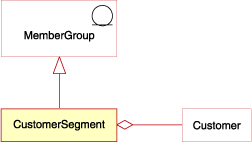Customer segment assets
A Customer Segments package. Customer Segments are specific to a particular Store, and thus the Customer Segments package is shown as dependent on the Store.
Customer segments help organize your marketing efforts by grouping the targets of your marketing messages. Customer segments are typically created by a Marketing Manager.
The following diagram illustrates the customer segment and collaboration assets in the WebSphere Commerce Server:

- Customer segment
- Customer
- Member group
- A customer segment incorporates registration information, demographics, address information,
customer culture, purchase history, and other miscellaneous attributes which define a dynamic group
of customers or accounts. Customer segments serve as targets for advertising, promotions, suggestive
selling, and email activities. We must create customer segments before you create campaigns.
Segments are considered dynamic because customers belong to them based on their personal data, and
purchase history, both of which can change. For example, we might create segments that are based on
a customer's registration status. If we create a segment that requires customers to be registered
to qualify, an unregistered customer is excluded. If that same customer registers later, they would
then become a member of that target segment, and would continue to be a member until the segment is
deleted.
Customer segments also support static criteria. We can explicitly include or exclude particular customers or accounts, which overrides any defined dynamic criteria. For example, we can include a customer in a segment that they would otherwise not match, or exclude an account from a segment that it would otherwise match. If both static and dynamic criteria are defined in the same customer segment, the dynamic criteria is evaluated first, then the static criteria.
- A user of an online store.
- Member groups implement role-based control in WebSphere Commerce.
Related concepts
Store data information model